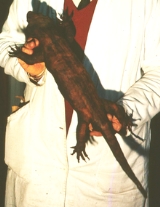
Kawekaweau
Encyclopedia
The Kawekaweau or Delcourt's Giant Gecko, Hoplodactylus delcourti, was by far the largest of all gecko
s with a snout to vent length of 370 mm and an overall length of at least 600 mm. It was endemic to New Zealand
and is now believed to be extinct. This would make Leach's giant gecko
of New Caledonia
, at 360mm in total length, the largest surviving species of gecko in the world - this leaves the endangered Duvaucel's gecko as the largest surviving species of gecko in New Zealand and one of the largest in the world.
This animal's specific epithet is after the surname of French museum worker Alain Delcourt - he was the person who discovered the forgotten specimen in the basement of the Marseille museum.
In 1870 a Māori chief killed a Kawekaweau he found under the bark of a dead rata
tree in the forests of the Waimana Valley, which are now protected as part of the northern section of Te Urewera National Park
. This is the only documented report of anyone ever seeing one of these animals alive. He described it as being "brownish with reddish stripes and as thick as a man's wrist". A single stuffed museum specimen was "discovered" in the basement of the Natural History Museum of Marseille
in 1986, but unfortunately the origins and date of collection of the specimen remain a total mystery, as when it was found, it was unlabelled. However, scientists examining it eventually came to the conclusion that it was from New Zealand and was in fact the lost "Kawekaweau", a giant and mysterious forest lizard of Maori oral tradition.
Gecko
Geckos are lizards belonging to the infraorder Gekkota, found in warm climates throughout the world. They range from 1.6 cm to 60 cm....
s with a snout to vent length of 370 mm and an overall length of at least 600 mm. It was endemic to New Zealand
New Zealand
New Zealand is an island country in the south-western Pacific Ocean comprising two main landmasses and numerous smaller islands. The country is situated some east of Australia across the Tasman Sea, and roughly south of the Pacific island nations of New Caledonia, Fiji, and Tonga...
and is now believed to be extinct. This would make Leach's giant gecko
Rhacodactylus leachianus
The New Caledonian Giant Gecko or Leach's Giant Gecko , is a large species of gecko first described by Georges Cuvier in 1829. It is often commonly referred to as a Leachie gecko . It is the largest of the Rhacodactylus geckos...
of New Caledonia
New Caledonia
New Caledonia is a special collectivity of France located in the southwest Pacific Ocean, east of Australia and about from Metropolitan France. The archipelago, part of the Melanesia subregion, includes the main island of Grande Terre, the Loyalty Islands, the Belep archipelago, the Isle of...
, at 360mm in total length, the largest surviving species of gecko in the world - this leaves the endangered Duvaucel's gecko as the largest surviving species of gecko in New Zealand and one of the largest in the world.
This animal's specific epithet is after the surname of French museum worker Alain Delcourt - he was the person who discovered the forgotten specimen in the basement of the Marseille museum.
In 1870 a Māori chief killed a Kawekaweau he found under the bark of a dead rata
Metrosideros robusta
Northern rātā , is a huge forest tree endemic to New Zealand. It grows up to 25 m or taller, and usually begins its life as a hemiepiphyte high in the branches of a mature forest tree; over centuries the young tree sends descending and girdling roots down and around the trunk of its host,...
tree in the forests of the Waimana Valley, which are now protected as part of the northern section of Te Urewera National Park
Te Urewera National Park
Te Urewera National Park is one of fourteen national parks within New Zealand and is the largest of the four in the North Island. Covering an area of approximately 2,127 km², it is in the north east of the Hawke's Bay region of the North Island....
. This is the only documented report of anyone ever seeing one of these animals alive. He described it as being "brownish with reddish stripes and as thick as a man's wrist". A single stuffed museum specimen was "discovered" in the basement of the Natural History Museum of Marseille
Marseille
Marseille , known in antiquity as Massalia , is the second largest city in France, after Paris, with a population of 852,395 within its administrative limits on a land area of . The urban area of Marseille extends beyond the city limits with a population of over 1,420,000 on an area of...
in 1986, but unfortunately the origins and date of collection of the specimen remain a total mystery, as when it was found, it was unlabelled. However, scientists examining it eventually came to the conclusion that it was from New Zealand and was in fact the lost "Kawekaweau", a giant and mysterious forest lizard of Maori oral tradition.
Further reading
- New Zealand frogs and reptiles, Brian Gill and Tony Whitaker, David Bateman publishing, 1996
External links
- A lost Menagerie, by Tim FlanneryTim FlanneryTimothy Fridtjof Flannery is an Australian mammalogist, palaeontologist, environmentalist and global warming activist....

